Geographic Representation
An Election For History Books
An Election For History Books
Geographic representation achieved, GOP wins
three seats, and several other records set
by Ken Martin
©The Austin Bulldog 2014
Posted Wednesday December 17, 2014 8:28pm
Updated Thursday December 18, 2014 6:21am
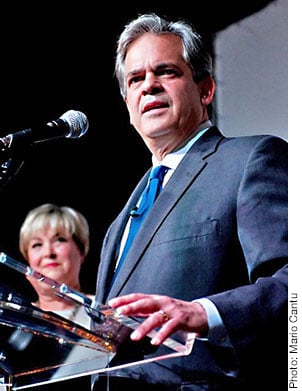 The largest landslide margin ever in an Austin mayoral runoff was achieved last night, as mayoral victor Steve Adler swamped incumbent Council Member Mike Martinez.
The largest landslide margin ever in an Austin mayoral runoff was achieved last night, as mayoral victor Steve Adler swamped incumbent Council Member Mike Martinez.
In Travis and Williamson counties a combined total of 80,669 votes were cast in the mayor’s race. Adler garnered 54,366 for 67.39 percent, while Martinez netted 26,303 for 32.61 percent.
Laura Morrison set the previous record by getting 65.0 percent of the votes in her 2008 runoff against Cid Galindo. Robert Barnstone got 64.98 percent in beating Sam Guzman in a 1988 runoff.
Lee Cooke in 1988 set the prevous record for margin of victory in a mayoral runoff when he got 58.43 percent of the votes to unseat incumbent mayor Frank Cooksey.
 At age 25, Greg Casar became the youngest Austin City Council member ever elected.
At age 25, Greg Casar became the youngest Austin City Council member ever elected.
Previously the youngest council member was 26-year-old Jeff Friedman, elected in 1971.
Friedman’s campaign consultant in that election, Peck Young, verified this, saying, “Jeff was the youngest when he was elected and Greg beats him by a year.” Casar will turn 26 in early May.
Casar ran a smart campaign to soundly defeat now two-time loser Laura Pressley (she got an impressive 44.48 percent of the votes in her one-on-one challenge of incumbent Martinez in 2012).
 Casar’s District 4 victory of 2,851 votes (64.62 percent) to her 1,561 (35.38 percent) resulted in part from her campaign’s faux pas. Perhaps not the least of which was getting involved in a discussion of the 9-11 attacks being an inside job, which drew intense media coverage, and her latest mail piece attacking Casar for, among other things, allegedly being an atheist.
Casar’s District 4 victory of 2,851 votes (64.62 percent) to her 1,561 (35.38 percent) resulted in part from her campaign’s faux pas. Perhaps not the least of which was getting involved in a discussion of the 9-11 attacks being an inside job, which drew intense media coverage, and her latest mail piece attacking Casar for, among other things, allegedly being an atheist.
Still, last night Pressley couldn’t resist a parting shot. A little after 8pm as early voting results showed she was already behind by more than 700 votes, she insisted on being quoted as saying, “Greg sold District 4 to special interests.”
In response Casar told The Austin Bulldog, “My track record stands up for working people and progressive ideals, even when special interests stood in the way. I’m going to stay committed to that.”
Women rule
What Can Austin Learn From California?
What Can Austin Learn From California?
Panel discussion focuses on how Golden State
experiences inform city’s move to 10-1 council
by Ken Martin
© The Austin Bulldog 2013
Posted Monday, May 6, 2013 2:00am
Updated with video link Tuesday May 7, 2013 10:50am
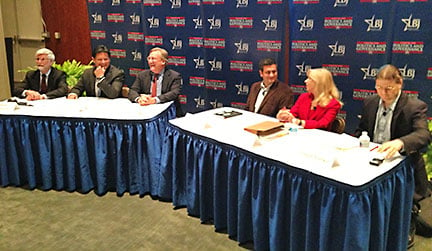 California’s official nickname, The Golden State, adopted in 1968, harkens back to the discovery of gold in 1848. Now the left-coast state’s experiences with using an independent citizens commission to draw maps for 177 seats in four different governing bodies offers a golden opportunity for learning how best to implement the City of Austin’s 10-1 plan.
California’s official nickname, The Golden State, adopted in 1968, harkens back to the discovery of gold in 1848. Now the left-coast state’s experiences with using an independent citizens commission to draw maps for 177 seats in four different governing bodies offers a golden opportunity for learning how best to implement the City of Austin’s 10-1 plan.
The 10-1 plan for electing council members from geographic districts was approved by 60 percent of Austin voters last November 6 who voted for Proposition 3. Work is well underway to establish an Independent Citizens Redistricting Commission (ICRC) that will draw council districts to be implemented in the November 2014 election. The ICRC’s duties are specified in Article II, Section 3 of the Austin City Charter.
Close to a hundred people attended the panel discussion held the evening of Thursday, May 2, at the Bass Lecture Hall on the University of Texas campus. Upwards of half of those raised their hands when asked who had applied to serve on the ICRC.
The event was jointly hosted by UT’s School of Law, the LBJ School’s Center for Politics and Governance, and Austinites for Geographic Representation.
Redistricting Veteran Shares His Wisdom
Redistricting Veteran Shares His Wisdom
Member of California Redistricting Commission
describes what to watch out for in Austin redistricting
by Ken Martin
© The Austin Bulldog 2013
Posted Thursday May 2, 2013 3:55pm
One of the 14 members of the California Redistricting Commission was the featured speaker at today’s luncheon hosted by Austinites for Geographic Representation and sponsored by the Austin Area Research Organization and League of Woman Voters Austin Area.
 Attorney Angelo Ancheta is director of the Katherine and George Alexander Community Law Center and an associate clinical professor at Santa Clara University, where he teaches on subjects including election law, voting rights, and immigration. He came to Austin at his own expense and with no other business here to help educate the community about what to expect going forward.
Attorney Angelo Ancheta is director of the Katherine and George Alexander Community Law Center and an associate clinical professor at Santa Clara University, where he teaches on subjects including election law, voting rights, and immigration. He came to Austin at his own expense and with no other business here to help educate the community about what to expect going forward.
From an applicants’ pool of 30,000 people, Ancheta won a slot on the California Redistricting Commission, the group that drew the maps for four different political jurisdictions, which included 80 seats in the California State Assembly, 40 seats in the California State Senate, 53 seats in the U.S. House of Representatives, and four seats on the California State Board of Equalization.
Ancheta’s experience in drawing maps for California, a state with 38 million people, offers good insights into what lies ahead for the City of Austin and its 845,000 people.
Austinites for Geographic Representation to Submit Petitions
Strategy Is To Maintain Ownership of the 10-1 Plan
with Independent Citizens Redistricting Commission
by Ken Martin
© The Austin Bulldog 2012
Posted Thursday, July 5, 2012 11:42am
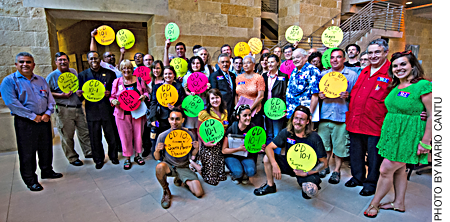
More than two dozen members of Austinites for Geographic Representation (AGR) attended a meeting Monday night and voted unanimously to continue the petition drive to get its plan on the ballot in November.
The plan calls for 10 council members to be elected from geographic districts, only the mayor to be elected at-large, and a nonpartisan Independent Citizens Redistricting Commission to draw a council districting plan that the council would have no choice but to accept.
Because Texas is one of the states subject to the Voting Rights Act of 1965, any districting plan would have to gain approval from the U.S. Department of Justice before implementation.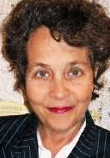 AGR has until July 16 to submit petitions with at least 20,000 valid signatures of registered City of Austin voters. At Monday night’s meeting, petition coordinator Linda Curtis said the group had about 20,600 valid signatures. Nearly every member volunteered to petition during the numerous 4th of July events scheduled around town, from neighborhood parades scheduled during the day to the big fireworks show in the evening.
AGR has until July 16 to submit petitions with at least 20,000 valid signatures of registered City of Austin voters. At Monday night’s meeting, petition coordinator Linda Curtis said the group had about 20,600 valid signatures. Nearly every member volunteered to petition during the numerous 4th of July events scheduled around town, from neighborhood parades scheduled during the day to the big fireworks show in the evening.
Council Puts 10-1 Plan on November Ballot
Votes 5-2 on Three Readings to Adopt Petition Language,
Votes 4-3 on First Reading to Also Put 8-2-1 on Ballot
by Ken Martin
© The Austin Bulldog
Posted Friday, June 29, 2012 3:33am
At 12:10am this morning, after taking nearly three hours of public testimony, the Austin City Council voted 5-2 (Mayor Lee Leffingwell and Council Member Bill Spelman opposed) to put on the ballot the exact plan long advocated by Austinites for Geographic Representation. The five votes in favor meant the motion made by Council Member Mike Martinez and seconded by Mayor Pro Tem Sheryl Cole passed on all three readings.
The proposal calls for 10 council members to be elected from geographic districts, only the mayor to be elected at large, and an Independent Citizens Redistricting Commission to draw a council districtricting plan that the council would have no choice but to adopt.
At 12:17am the council voted 4-3 (Cole, Martinez and Spelman opposed) to also put on the ballot the 8-2-1 plan. But because the motion did not get five votes, it only passed on first reading and will have to come back to the council—which doesn't meet again until August 2—for further consideration.
The 8-2-1 plan, sponsored by the mayor and Council Member Chris Riley, would have the mayor and two council members to be elected at-large and eight council members to be elected from geographic districts. This proposal does not include an Independent Citizens Redistricting Commission. Instead,according to the draft ordinance for this agenda item, “The boundaries of geographical single-member council districts shall be drawn by ordinance from time to time.” Meaning the council districts could be drawn in such a way that the City Council would decide the boundaries.
Citizens Group To Make Final Petition Push
Citizens Group To Make Final Petition Push
Austinites for Geographic Representation Claims to
Have 17,000 Signatures, and Shoots for 13,000 More
by Ken Martin
© The Austin Bulldog 2012
Posted Monday, June 4, 2012 11:01pm
It's been 15 months since Austinites for Geographic Representation held its first meeting in February 2011 at Huston-Tillotson University and the group has been steadily building a coalition of supporters and rounding up endorsements ever since.
The group's proposal to have 10 council members elected from geographic districts and only the mayor elected at large, and to have geographic districts drawn by an Independent Citizens Redistricting Commission, has gotten a lot of traction—including endorsements from a range of groups including the League of Women Voters of the Austin Area, Austin Neighborhoods Council, the and the Travis County Republican Party. (To see the full list of organizations and individuals endorsing the plan, click here.)
Even the council-appointed 2012 Charter Revision Committee backed the 10-1 plan with an Independent Citizens Redistricting Commission, though by a narrow 8-7 vote that triggered work by some on the losing end to continue lobbying for a hybrid plan that includes a couple of at-large council seats in addition to the mayor.
What the 10-1 plan has not gotten so far is broad public support from members of the Austin City Council. To date, only Council Member Mike Martinez has voiced unequivocal support for the plan.
Hence the grassroots effort by Austinites for Geographic Representation continues to gather the signatures of 20,000 registered city voters.
Hard Fought, Heartfelt Charter Decision
Charter Revision Committee Votes 8-7
to Back 10-1 Plan for Council Elections
by Ken Martin
© The Austin Bulldog 2012
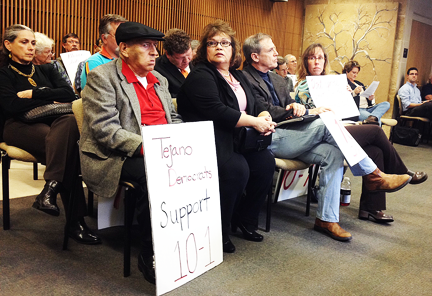 Former State Senator Gonzalo Barrientos knew things might get dicey at the final scheduled meeting of the 2012 Charter Revision Committee he chairs.
Former State Senator Gonzalo Barrientos knew things might get dicey at the final scheduled meeting of the 2012 Charter Revision Committee he chairs.
He brought in retired Travis County District Judge Bob Perkins, who sat on the 331st District Court bench for nearly three decades, to referee as parliamentarian, if need be.
It was a guaranteed evening of high drama given the scheduled final vote to decide what form of electoral system the committee would recommend to the Austin City Council. That vote culminated five months of public meetings in which the committee members listened to hundreds of citizens and heard the advice of several attorneys well versed in election law and compliance with the federal Voting Rights Act.
After voting 12-2 to recommend that a measure be put on the ballot to have an Independent Citizens Redistricting Commission draw council district lines should voters should approve some form of geographic representation—something voters nixed six times before between 1973 and 2002—the committee was at last ready to deal with what form of geographic representation to recommend.
During a sometimes heated and often passionate discussion that lasted nearly an hour, the deeply split committee was unable to reach a compromise.
The final vote was to recommend the 10-1 plan—in which 10 council members would be elected from geographic districts and only the mayor elected by all voters—passed 8-7.
The vote on a previous motion to recommend a 10-2-1 plan, where the mayor and two council members would be elected at large, failed 7-8.
There were calls for compromise that would unite the group and strengthen its recommendation for what the City Council should put on the ballot in November but in the end that was fruitless.
Committee members budged not one inch from the positions they had announced in previous public meetings.
Intense debate, no surrender
Grass-roots democracy pushing petition
Get on Ballot for May 2012 Election
Austinites for Geographic Representation
Needs 20,000 Signatures by Mid-January
by Ken Martin
© The Austin Bulldog 2011
What we want? Council districts!
When do we want them? Now!
How will we get them? Petition!
When do we start? Now!
Such might be the chants of members of Austinites for Geographic Representation if they were to take to the streets like the protestors of Occupy Wall Street and Occupy Austin.
But you won’t be hearing chants from the members of this grass-roots citizens initiative to get on the ballot a proposition to establish a nonpartisan Independent Citizen Redistricting Commission that would draw 10 council districts that the Austin City Council would have no choice but to adopt. The group’s plan calls for only the mayor to continue being elected at-large.
Austin is the most populous city in the United States to elect its entire city council at-large, and the only major metropolitan city in Texas to do so, according to a report produced last month by City Demographer Ryan Robinson. Austin voters, however, have voted down propositions for some form of council districts six times between 1973 and 2002.
Austinites for Geographic Representation has scheduled a press conference for noon tomorrow at City Hall and a campaign kickoff rally 3-5pm Saturday at Mexitas Restaurant, 1109 N. I-35. The group has leased an office at 7901 Cameron Road and formed a Specific Purpose Political Action Committee whose treasurer, Stacy Suits, ran two unsuccessful campaigns for geographic representation in 1985 and 1988.
 The petition drive is being organized by Linda Curtis of ChangeAustin.org. Curtis has previously led four successful petition drives to get measures before Austin voters. This petition campaign is not employing paid signature gatherers but instead has formed a broad coalition of community organizations that will actively circulate petitions. This initiative has been endorsed by a number of organizations including ChangeAustin.org, Del Valle Community Coalition, El Concilio, Gray Panthers of Austin, LULAC District 7, LULAC District 12, NAACP Austin, Texans for Accountable Government, Travis County Green Party, and University of Texas at Austin Student Government.The League of Women Voters Austin Area is meeting tonight to consider endorsing the initiative, said chapter president Stewart Snider. The Austin Neighborhoods Council may consider an endorsement at its October 26 meeting. (To see a complete list of organizations and individuals endorsing this initiative, click here.) The petition drive has a Facebook page and will soon publish petition forms online.
The petition drive is being organized by Linda Curtis of ChangeAustin.org. Curtis has previously led four successful petition drives to get measures before Austin voters. This petition campaign is not employing paid signature gatherers but instead has formed a broad coalition of community organizations that will actively circulate petitions. This initiative has been endorsed by a number of organizations including ChangeAustin.org, Del Valle Community Coalition, El Concilio, Gray Panthers of Austin, LULAC District 7, LULAC District 12, NAACP Austin, Texans for Accountable Government, Travis County Green Party, and University of Texas at Austin Student Government.The League of Women Voters Austin Area is meeting tonight to consider endorsing the initiative, said chapter president Stewart Snider. The Austin Neighborhoods Council may consider an endorsement at its October 26 meeting. (To see a complete list of organizations and individuals endorsing this initiative, click here.) The petition drive has a Facebook page and will soon publish petition forms online.
The petition drive, if successful, would force the city council to put its own proposed charter amendmentson the May ballot as well.Article XI, Section 5 of the Texas Constitution states that “no city charter shall be altered, amended or repealed oftener than every two years.” To prepare for that possibility, the 2012 Charter Revision Committee has a January 31 deadline to submit its recommendations for council consideration.
Charter committee backs seven changes







